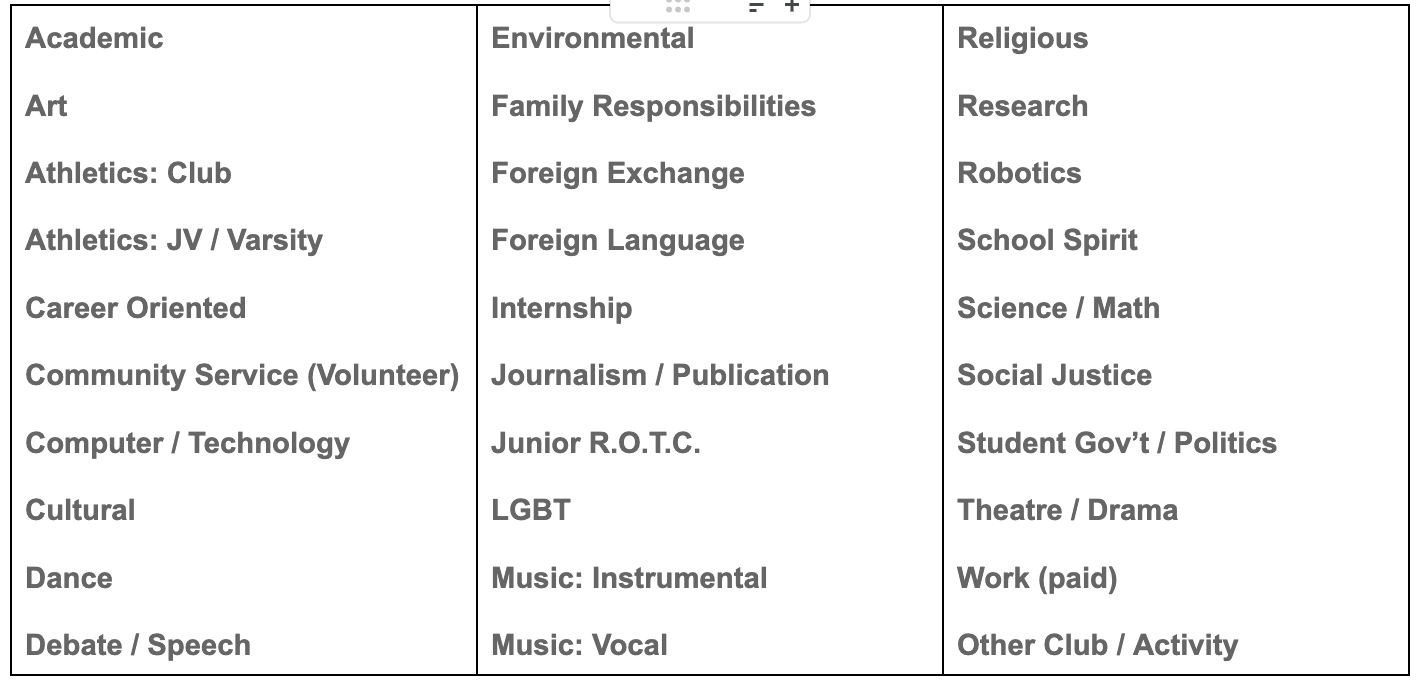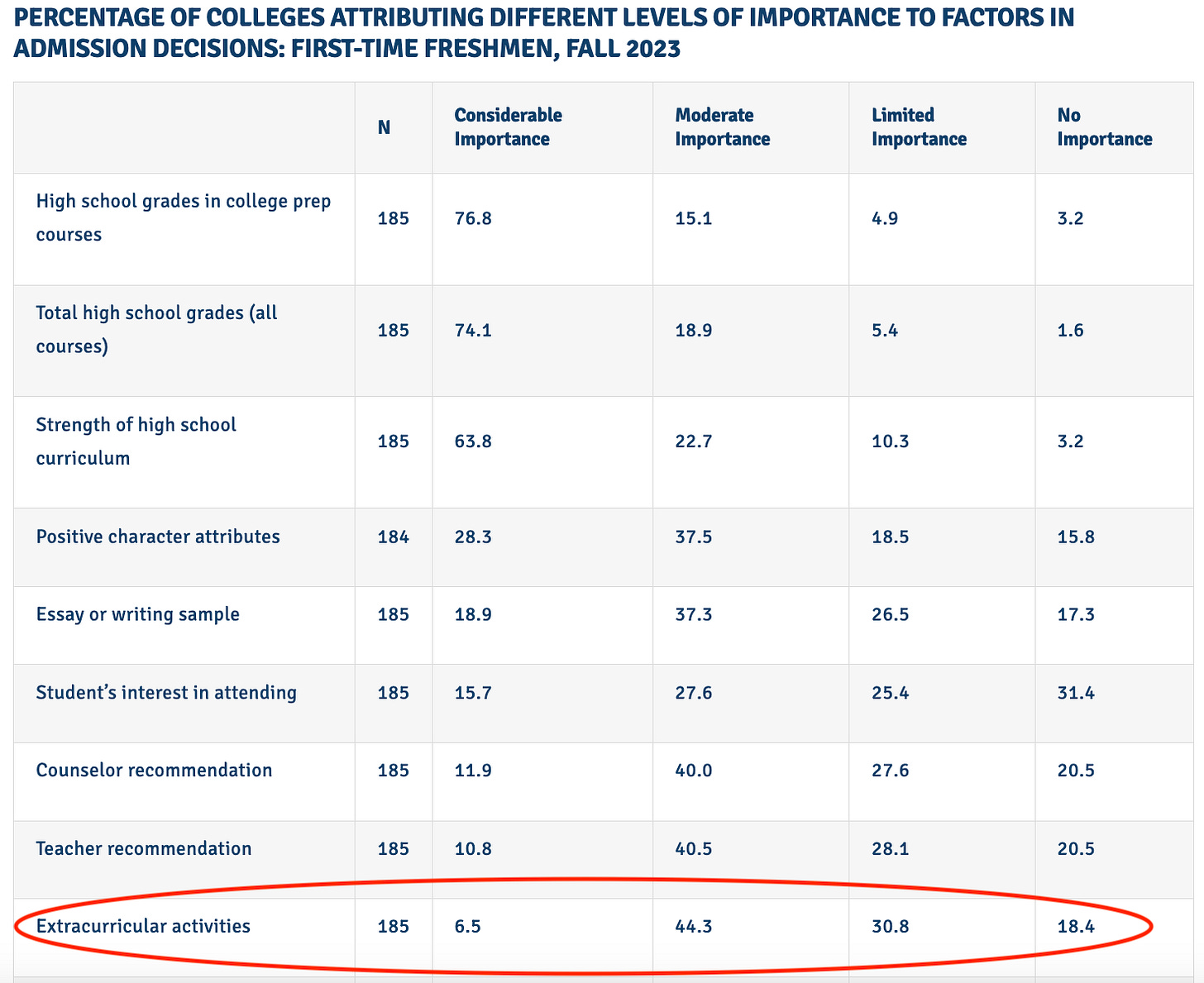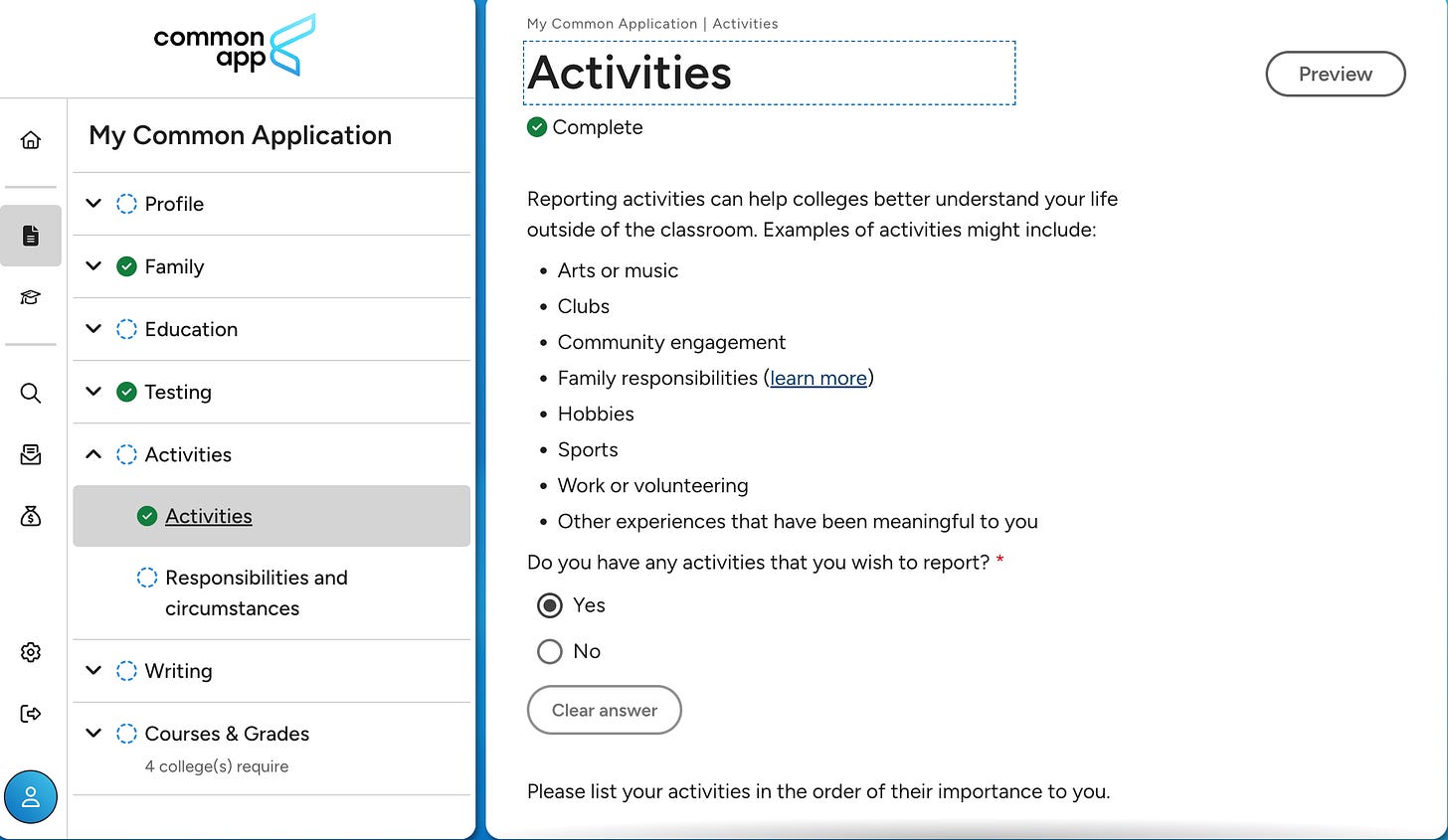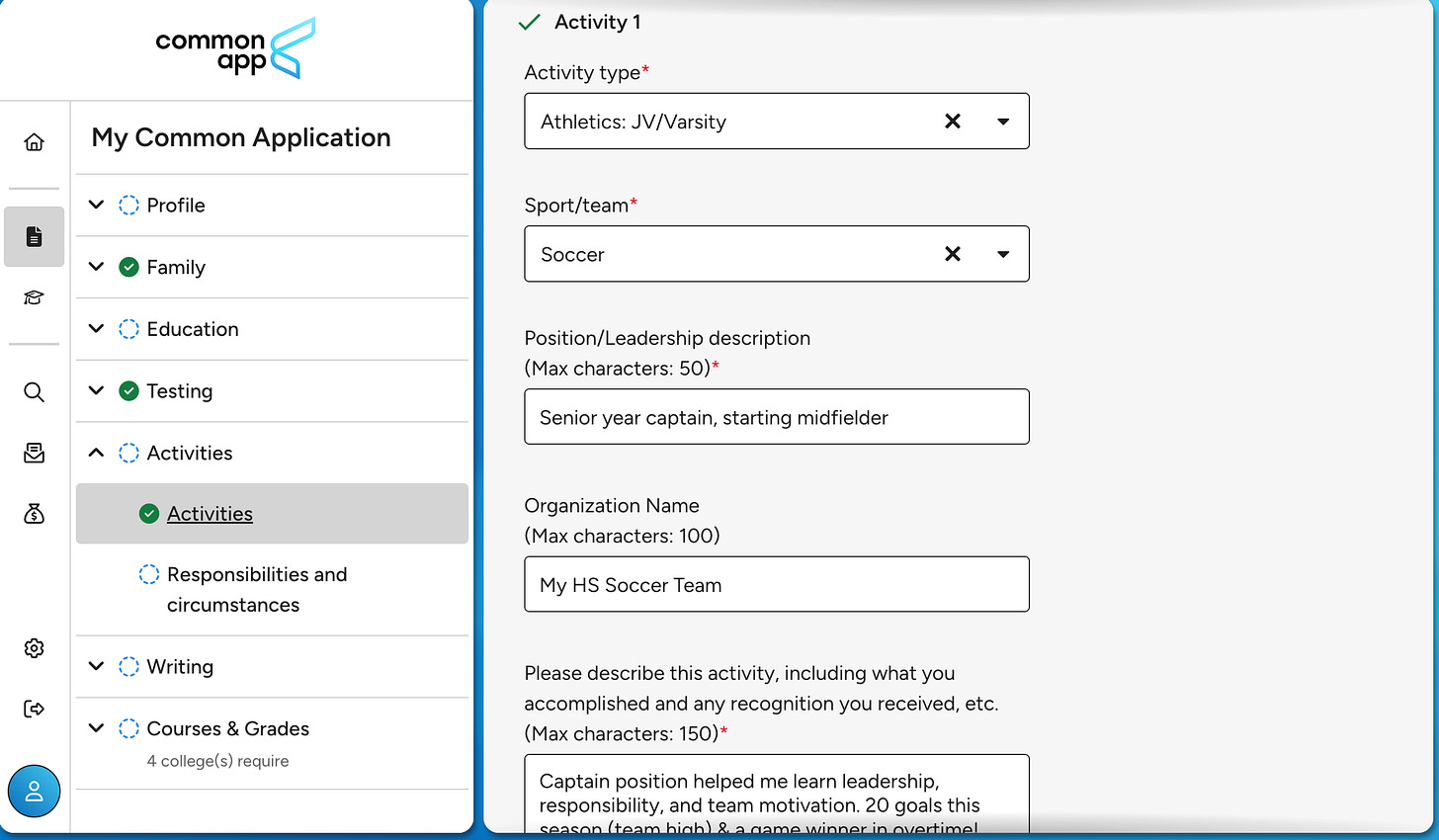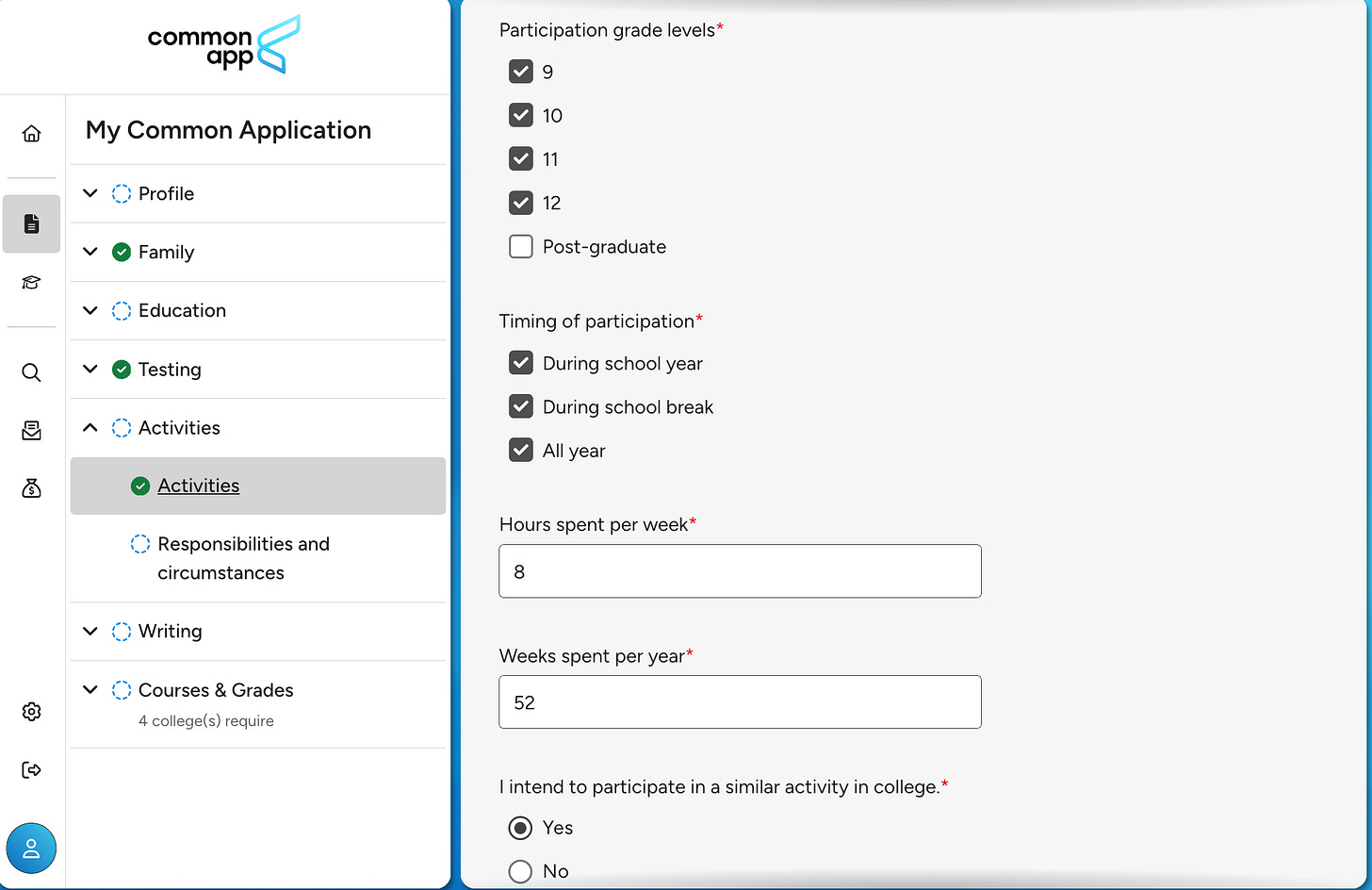Common App Section by Section - Activities
Showcase your extracurricular achievements in the Activities section of the Common App with these expert tips.
Activities
In the ‘Activities’ section of the Common App you’ll be asked to provide information about how you spend your time outside of the classroom.
Why? Colleges want to know how you *choose* to spend your time.
You don’t have much of a choice about going to high school. You might not even have that much of a say in what courses you take. But you do generally get to exercise more choice about how you spend your time outside of school.
Your activity choices show your likes and dislikes, your passions and commitments, and your skills and unique abilities. They also give colleges an idea about how you may contribute to student life and community at their university, should you be accepted.
Common activities include clubs, sports, and organisations associated with your high school.
But, don’t forget to look beyond your school. More often than not, your activities will also include time spent in your community - say at a job, at volunteer opportunities, assisting with family obligations, and so on.
Budget at least 1 hour for completing this section - it can take a while to organise your thoughts.
How To “Ace” The Activities Section
Three actions will help you tell your best story:
Include *all* that you do
Give context
Put things in order
It usually helps if you do this bit outside of the Common App - say on a piece of paper, or in your notes app. Once you have your full list of activities, what you want to say about them, and the order in which you want them to appear, then use the Common App to enter them.
1. Include *all* that you do
The most common mistake I see is that students under-represent what they do.
Do you take care of a family member or younger sibling, babysit, or pet-sit? List it.
Did you help your family gather canned foods and donations at a local shelter? List it.
Did you have a job? List it.
Binge watching an anime series on Netflix probably isn’t going to warrant inclusion, but many other items that demonstrate traits colleges are looking for - intellectual curiosity, leadership, responsibility, learning, service, etc… - should absolutely be included.
The Common Application asks you to select an activity type, and reviewing this helpful list can often jog your memory -
2. Give Context
For each activity, you’ll be asked to provide your role or position, the name of the organisation, and a description of the activity, including what you accomplished and any recognition you received.
Each has a character limit (including spaces). Don’t try to use complete sentences - it’s perfectly OK to use fragments.
Remember that your audience - admissions counsellors reading your application - are probably not familiar with your role and responsibilities, organisation, or what you accomplished. If the activity contains an acronym that isn’t super widely known (e.g. NHS or PTA), include the full name instead.
Your goal is to help them understand not just “what” you did but also “how” or “why” that activity was meaningful to you.
Diversify verbs: Use a variety of action words to describe your roles clearly. Here’s a helpful list.DO this: “Acted as co-captain of the soccer team”, “Led basketball team in assists”
DON’T do this: “I played soccer”, “I played basketball”
Use present tense for ongoing roles: Reflect current responsibilities accurately.DO this: “Building humanoid robot”
DON’T do this: “Built a robot”
Be concise: Every word character counts; trim down to the essentials.DO this: “Raised $5,000 for new band instruments”
DON’T do this: “I worked really hard to raise money by organising multiple events and reaching out to different people in the community to collect $5,000 that we then used to buy brand new band instruments”
Highlight impact: Include numbers or outcomes to show your contribution.DO this: “Tutored 10 students weekly in algebra, improving all by at least a letter grade”
DON’T do this: “Tutored students in math”
Show leadership: Emphasise any leadership roles or responsibilities.DO this: “Led a team of 5 in organising a community service project”
DON’T do this: “Participated in a community service project”
Demonstrate growth: Tell them what you’ve learned.DO this: “Developed time & project management skills planning a charity event”
DON’T do this: “Planned a charity event”
3. Put Things In Order
List your most important activity first, then the next most important, and so on.
What’s most important? You get to decide. It could be the activity where you spent the most time, or it could be the activity that gives you the most joy. Don’t try to guess what college admissions officers might find most important. Tell your story, your way.
Stuck? Here are a few ideas that might help -
More recent activities are usually listed before less frequent activities (e.g. your senior year activities vs that one activity you only participated in during 9th grade)
Multiple-year activities (demonstrating longer commitment) are usually listed before single-year activities
Activities where you held a leadership position are usually listed before those where you were a member or volunteer
Activities where you received an award (or the activity itself was the result of an award or honour) are usually listed before those where you did not
Maintaining Perspective
I also want to take a moment to help contextualise the relative importance of extracurricular activities in admission decisions. According to NACAC, it is the 9th most important factor, considerably less important than academic performance and character.
So… it is worthwhile to complete this section of your application, and to do your best to tell your story. It probably isn’t worth hours and hours of your time re-working endless lists, wordsmithing, or worrying or stressing about.
Completing The Common App
Information included in the ‘Activities’ section of your application will be sent to all your colleges and universities.
10 Activities
You are given space for 10 activities.
You do not need to use all 10 - most students won’t. (Conversely, a few of you may need to be choosy about what to include given the space constraints.)
More is not necessarily better. 3-4 activities can tell just as compelling a story as maxing out the space provided.
Order activities by their importance to you, starting with your most important activity.
College admissions officers do not have a preference for one activity type over another. They are simply looking to learn more about your interests and how you’ve chosen to spend your time outside of the classroom. So, the order listed is truly up to you.
Activity Type
Sometimes your activity might fit into multiple categories. If that’s the case, choose whichever one you believe best represents it.
Also, don’t be afraid to use the ‘Other Club / Activity’ type if what you're describing doesn’t neatly fit into the pre-defined categories.
Group like activities by type to save space and improve readability by admissions staff.
For example, if you have three different lines for your soccer team - one for your high school team, one for your traveling/club team, and one for a soccer camp you attended and/or led - you may consider folding these into a single line item.
Position/Leadership, Organization Name, and Description
If you’ve held multiple positions or roles, lead with the highest or most recent position, and then list prior roles.
For example, suppose you joined a club in 9th grade, continued to participate in 10th grade, served as Treasurer for 11th grade, and Vice President in 12th grade. You might choose to list this as “Vice President (12th), Treasurer (11th), member”.
Refer to my previous comments - How to “Ace” the Activities Section - for specific notes applicable to the Organization Name and Description fields.
Remember, you are limited by character counts (including spaces), not words. You do not need to use complete sentences. You do want to be as descriptive as possible.
Participation Grade Levels
These activities should be ones you participated in during 9th grade year or later.
If an activity occurs over the summer (i.e. between school years), you should attribute it to the rising school year. For example, if during the summer after completing 9th grade (but before starting 10th grade), you took on a part-time job… you would attribute this to your 10th grade year.
If you believe you’ll be continuing an activity during your senior year of high school, go ahead and indicate grade ‘12’ participation even if you haven’t had the opportunity to participate just yet. For example, if you are completing college apps in the fall, but you compete in a sport that next takes place during the spring of your senior year, go ahead and select that you are participating in 12th grade too.
Timing, Hours, Weeks
Colleges know and understand that some activities have “busy” periods - weeks where you spend many hours participating - and “slow” periods. Just do your best to estimate an average. For example, if during softball season you spend 10 hours per week but in the offseason you spend 2 hours per week, estimate to get at a number of hours representative of your overall softball time commitment.
Similar guidance holds for estimating weeks spent per year. As a general rule -
A summer is 10 weeks
A sports season is 10-12 weeks
A school year is 40 weeks
Participation in College
The question about intent to continue an activity in college isn’t binding or a hard commitment.
Colleges are genuinely curious about your level of interest and ability to continue an activity at the university level. For example, you might be a member of the varsity tennis team at your high school. Selecting “yes” doesn’t mean you’re committing to play NCAA DIV II tennis; similarly, selecting “no” doesn’t mean you can’t ever play tennis again. Remember that participation in college can take many forms. This could be college-level athletics, or it could be club team athletics, or it could be just an activity you do with friends on nice weather days.
Net, if you are at all leaning towards continued interest in college, go ahead and say “yes” to this question.




